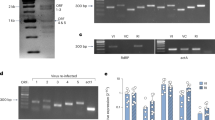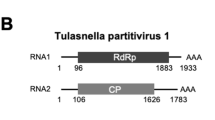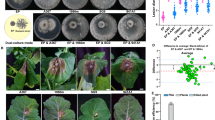Abstract
Fungi are generally thought to live in host plants with a single lifestyle, being parasitism, commensalism, or mutualism. The former, known as phytopathogenic fungi, cause various plant diseases that result in significant losses every year; while the latter, such as endophytic fungi, can confer fitness to the host plants. It is unclear whether biological factors can modulate the parasitic and mutualistic traits of a fungus. In this study, we isolated and characterized a mycovirus from an endophytic strain of the fungus Pestalotiopsis theae, a pathogen of tea (Camellia sinensis). Based on molecular analysis, we tentatively designated the mycovirus as Pestalotiopsis theae chrysovirus-1 (PtCV1), a novel member of the family Chrysoviridae, genus Alphachrysovirus. PtCV1 has four double-stranded (ds) RNAs as its genome, ranging from 0.9 to 3.4 kbp in size, encapsidated in isometric particles. PtCV1 significantly reduced the growth rates of its host fungus in vitro (ANOVA; P-value < 0.001) and abolished its virulence in planta (ANOVA; P-value < 0.001), converting its host fungus to a non-pathogenic endophyte on tea leaves, while PtCV1-free isolates were highly virulent. Moreover, the presence of PtCV1 conferred high resistance to the host plants against the virulent P. theae strains. Here we report a mycovirus that modulates endophytic and phytopathogenic fungal traits and provides an alternative approach to biological control of plant diseases caused by fungi.
Similar content being viewed by others
Log in or create a free account to read this content
Gain free access to this article, as well as selected content from this journal and more on nature.com
or
References
Arnold AE, Mejia LC, Kyllo D, Rojas EI, Maynard Z, Robbins N, et al. Fungal endophytes limit pathogen damage in a tropical tree. Proc Natl Acad Sci USA 2003;100:15649–54.
Stone JK, Bacon CW, White J. An overview of endophytic microbes: endophytism defined. In: Bacon CW, White JF, editors. Microbial endophytes. New York: Marcel Decker Inc; 2000.
Rodriguez RJ, White JF, Arnold AE, Redman RS. Fungal endophytes: diversity and functional roles. New Phytol. 2009;182:314–30.
Bonfante P, Genre A. Mechanisms underlying beneficial plantfungus interactions in mycorrhizal symbiosis. Nat Commun 2010;1:48.
Abdelaziz M, Kim D, Ali S, Fedoroff N, Al-Babili S. The endophytic fungus piriformospora indica enhances arabidopsis thaliana growth and modulates Na+/K+ homeostasis under salt stress conditions. Plant Sci 2017;263:107–15.
Yadav A, Yadav K. Exploring the potential of endophytes in agriculture: a minireview. Adv Plants Agric Res 2017;6:102–6.
Vega FE. The use of fungal entomopathogens as endophytes in biological control: a review. Mycologia 2018;110:4–30.
Maharachchikumbura SSN, Hyde KD, Grenewald JZ, Xu J, Crous PW. Pestalotiopsis revisited. Stud Mycol. 2014;79:121–86.
Liu F, Hou L, Raza M, Cai L. Pestalotiopsis and allied genera from Camellia, with description of 11 new species from China. Sci Rep. 2017;7:866.
Ghabrial SA, Castón JR, Jiang D, Nibert ML, Suzuki N. 50-plus years of fungal viruses. Virology 2015;479-480:356–68.
Kotta-Loizou I, Castón JR, Coutts RHA, Hillman BI, Jiang D, Kim D-H, et al. ICTV virus taxonomy profile: Chrysoviridae. J Gen Virol 2020;101:143–4.
Suzuki N, Ghabrial SA, Kim K, Pearson M, Marzano SL, Yaegashi H, et al. ICTV virus taxonomy profile: Hypoviridae. J Gen Virol 2018;99:615–6.
Anagnostakis SL. Biological control of chestnut blight. Science 1982;215:466–71.
MacDonald W, Fulbright D. Biological control of chestnut blight: use and limitations of transmissible hypovirulence. Plant Dis 1991;75:656–61.
Nuss DL. Biological control of chestnut blight: an example of virus-mediated attenuation of fungal pathogenesis. Microbiol Mol Biol Rev. 1992;56:561–76.
Bamford DH, Pietilä MK, Roine E, Atanasova NS, Dienstbier A, Oksanen HM, et al. ICTV virus taxonomy profile: Pleolipoviridae. J Gen Virol 2017;98:2916–7.
Yu X, Li B, Fu Y, Xie J, Cheng J, Ghabrial SA, et al. Extracellular transmission of a DNA mycovirus and its use as a natural fungicide. Proc Natl Acad Sci USA 2013;110:1452–7.
Herrero N, Márquez S, Zabalgogeazcoa I. Mycoviruses are common among different species of endophytic fungi of grasses. Arch Virol 2009;154:327–30.
Rosseto P, Costa AT, Polonio JC, da Silva AA, Pamphile JA, Azevedo JL. Investigation of mycoviruses in endophytic and phytopathogenic strains of Colletotrichum from different hosts. Genet Mol Res 2016;15:15017651.
Márquez LM, Redman RS, Rodriguez RJ, Roossinck MJ. A virus in a fungus in a plant: three-way symbiosis required for thermal tolerance. Science 2007;315:513–5.
Wang ZH, Zhao ZX, Hong N, Ni DJ, Cai L, Xu WX, et al. Characterization of causal agents of a novel disease inducing brown-black spots on tender tea leaves in China. Plant Dis 2017;101:1802–11.
McDougal R, Stewart A, Bradshaw R. Transformation of cyclaneusma minus with green fluorescent protein (gfp) to enable screening of fungi for biocontrol activity. Forests 2012;3:83–94.
Jia H, Dong K, Zhou L, Wang G, Hong N, Jiang D, et al. A dsRNA virus with filamentous viral particles. Nat Commun 2017;8:168.
Liu H, Fu Y, Jiang D, Li G, Xie J, Peng Y, et al. A novel mycovirus that is related to the human pathogen hepatitis E virus and rubi-like viruses. J Virol 2009;83:1981–91.
Tamura K, Stecher G, Peterson D, Filipski A, Kumar S. MEGA6: Molecular evolutionary genetics analysis version 6.0. Mol Biol Evol 2013;30:2725–9.
Wang L, Jiang J, Wang Y, Hong N, Zhang F, Xu W, et al. Hypovirulence of the phytopathogenic fungus Botryosphaeria dothidea: association with a coinfecting chrysovirus and a partitivirus. J Virol 2014;88:7517–27.
Schneider CA, Rasband WS, Eliceiri KW. NIH Image to ImageJ: 25 years of image analysis. Nat Methods 2012;9:671–5.
Wu M, Jin F, Zhang J, Yang L, Jiang D, Li G. Characterization of a novel bipartite double-stranded RNA mycovirus conferring hypovirulence in the phytopathogenic fungus Botrytis porri. J Virol 2012;86:6605–19.
Zhang L, Fu Y, Xie J, Jiang D, Li G, Yi X. A novel virus that infecting hypovirulent strain XG36-1 of plant fungal pathogen Sclerotinia sclerotiorum. Virol J 2009;6:96.
Yoo S-D, Cho Y-H, Sheen J. Arabidopsis mesophyll protoplasts: A versatile cell system for transient gene expression analysis. Nat Protoc 2007;2:1565–72.
Doehlemann G, van der Linde K, Aßmann D, Schwammbach D, Hof A, Mohanty A, et al. Pep1, a secreted effector protein of Ustilago maydis, is required for successful invasion of plant cells. PLoS Pathog 2009;5:e1000290.
Zhong J, Pang XD, Zhu HJ, Gao BD, Huang WK, Zhou Q. Molecular characterization of a trisegmented mycovirus from the plant pathogenic fungus Colletotrichum gloeosporioides. Viruses 2016;8:268.
Covelli L, Coutts RHA, Di Serio F, Citir A, Acikgoz S, Hernández C, et al. Cherry chlorotic rusty spot and Amasya cherry diseases are associated with a complex pattern of mycoviral-like double-stranded RNAs. I. Characterization of a new species in the genus Chrysovirus. J Gen Virol 2004;85:3389–97.
Jiang D, Ghabrial SA. Molecular characterization of Penicillium chrysogenum virus: reconsideration of the taxonomy of the genus Chrysovirus. J Gen Virol 2004;85:2111–21.
Ghabrial S, Castón A, Coutts JR, Hillman RHA, Jiang BI, Kim D. DH, et al. ICTV virus taxonomy profile: Chrysoviridae. J Gen Virol. 2018;99:19–20.
Lin YH, Hisano S, Yaegashi H, Kanematsu S, Suzuki N. A second quadrivirus strain from the phytopathogenic filamentous fungus Rosellinia necatrix. Arch Virol 2013;158:1093–8.
Kanhayuwa L, Kotta-Loizou I, Özkan S, Gunning AP, Coutts RHA. A novel mycovirus from Aspergillus fumigatus contains four unique dsRNAs as its genome and is infectious as dsRNA. Proc Natl Acad Sci USA. 2015;112:9100–5.
Ejmal MA, Holland DJ, MacDiarmid RM, Pearson MN. The effect of Aspergillus thermomutatus chrysovirus 1 on the biology of three aspergillus species. Viruses 2018;10:539.
Carroll G. Forest endophytes: pattern and process. Can J Bot 2011;73:316–24.
Wheeler DL, Dung JKS, Johnson DA. From pathogen to endophyte: an endophytic population of Verticillium dahliae evolved from a sympatric pathogenic population. N Phytol 2019;222:497–510.
Redman R, Freeman S, Clifton DR, Morrel J, Brown G, Rodriguez RJ. Biochemical analysis of plant protection afforded by a non-pathogenic endophytic mutant of Colletotrichum magna. Plant Physiol 1999;119:795–804.
Schulz B, Boyle C. The endophytic continuum. Mycol Res 2005;109:661–86.
Redman R, Dunigan D, Rodriquez R. Fungal symbiosis from mutualism to parasitism: who controls the outcome, host or invader? New Phytol 2001;151:705–16.
Álvarez-Loayza P, White J, Torrez M, Balslev H, Kristiansen T, Svennin J, et al. Light converts endosymbiotic fungus to pathogen, influencing seedling survival and niche-space filling of a common tropical tree, Iriartea deltoidea. PLoS ONE 2011;6:e16386.
Hiruma K, Gerlach N, Sacrista S, Nakano RT, Hacquard S, Kracher B, et al. Root endophyte Colletotrichum tofieldiae confers plant fitness benefits that are phosphate status dependent. Cell 2016;165:464–74.
Rai M, Agarkar G. Plant–fungal interactions: what triggers the fungi to switch among lifestyles? Crit Rev Microbiol 2016;42:428–38.
Freeman S, Rodriguez RJ. Genetic conversion of a fungal plant pathogen to a nonpathogenic, endophytic mutualist. Science 1993;260:75–8.
Shah UA, Kotta-Loizou I, Fitt BDL, Coutts RHA. Identification, molecular characterization, and biology of a novel quadrivirus infecting the phytopathogenic fungus Leptosphaeria biglobosa. Viruses 2019;11:9.
Shah UA, Kotta-Loizou I, Fitt BDL, Coutts RHA. Mycovirus-Induced hypervirulence of Leptosphaeria biglobosa enhances systemic acquired resistance to Leptosphaeria maculans in Brassica napus. Mol Plant Microbe Interact. 2020;3:98–107.
Zhang H, Xie J, Fu Y, Cheng J, Qu Z, Zhao Z, et al. A 2-kb mycovirus converts a pathogenic fungus into a beneficial endophyte for brassica protection and yield enhancement. Mol Plant 2020;13:1420–33.
Xie J, Jiang D. New insights into mycoviruses and exploration for the biological control of crop fungal diseases. Annu Rev Phytopathol 2014;52:45–68.
Acknowledgements
This work was supported by grants from the National Natural Science Foundation of China (No. 31201488) and the Fundamental Research Funds for Environment and Plant Protection Institute, CATAS (No. 1630042019017). The authors would like to thank Jiatao Xie, Heng Kang, and Chaoxi Luo, College of Plant Science and Technology, Huazhong Agricultural University, Wuhan, China, for kindly assisting with the cloning experiments, endophyte studies, and generously contributing the GFP plasmid, respectively. We also thank Robert H. A. Coutts for assistance with the English language and helpful discussions.
Author information
Authors and Affiliations
Contributions
W.X. designed the investigation and wrote the manuscript, L.Z. conducted experiments, including cloning, TEM, transfection, and pathogenicity assays, X.L. conducted experiments, including confocal laser scanning microscopy and biological analysis, S.L., D.N., N.H., and G.W. were involved in project supervision and funding acquisition, and I.K.-L. performed the statistical analysis and improved the manuscript.
Corresponding author
Ethics declarations
Conflict of interest
The authors declare that they have no conflict of interest.
Additional information
Publisher’s note Springer Nature remains neutral with regard to jurisdictional claims in published maps and institutional affiliations.
Rights and permissions
About this article
Cite this article
Zhou, L., Li, X., Kotta-Loizou, I. et al. A mycovirus modulates the endophytic and pathogenic traits of a plant associated fungus. ISME J 15, 1893–1906 (2021). https://doi.org/10.1038/s41396-021-00892-3
Received:
Revised:
Accepted:
Published:
Issue date:
DOI: https://doi.org/10.1038/s41396-021-00892-3
This article is cited by
-
Genomic insights reveal community structure and phylogenetic associations of endohyphal bacteria and viruses in fungal endophytes
Environmental Microbiome (2025)
-
Fungicidal potential of Trichoderma isolates from soil in managing root rot disease caused by Fusarium solani and Rhizoctonia solani in tomato plants
Journal of Plant Pathology (2025)
-
Enhancing Plant Disease Resistance: Insights from Biocontrol Agent Strategies
Journal of Plant Growth Regulation (2025)
-
Molecular characterization of a novel narnavirus from the plant-pathogenic fungus Ustilaginoidea virens
Archives of Virology (2025)
-
A biocontrol perspective on mycoviruses in fungal pathogen management
Journal of Plant Diseases and Protection (2025)



